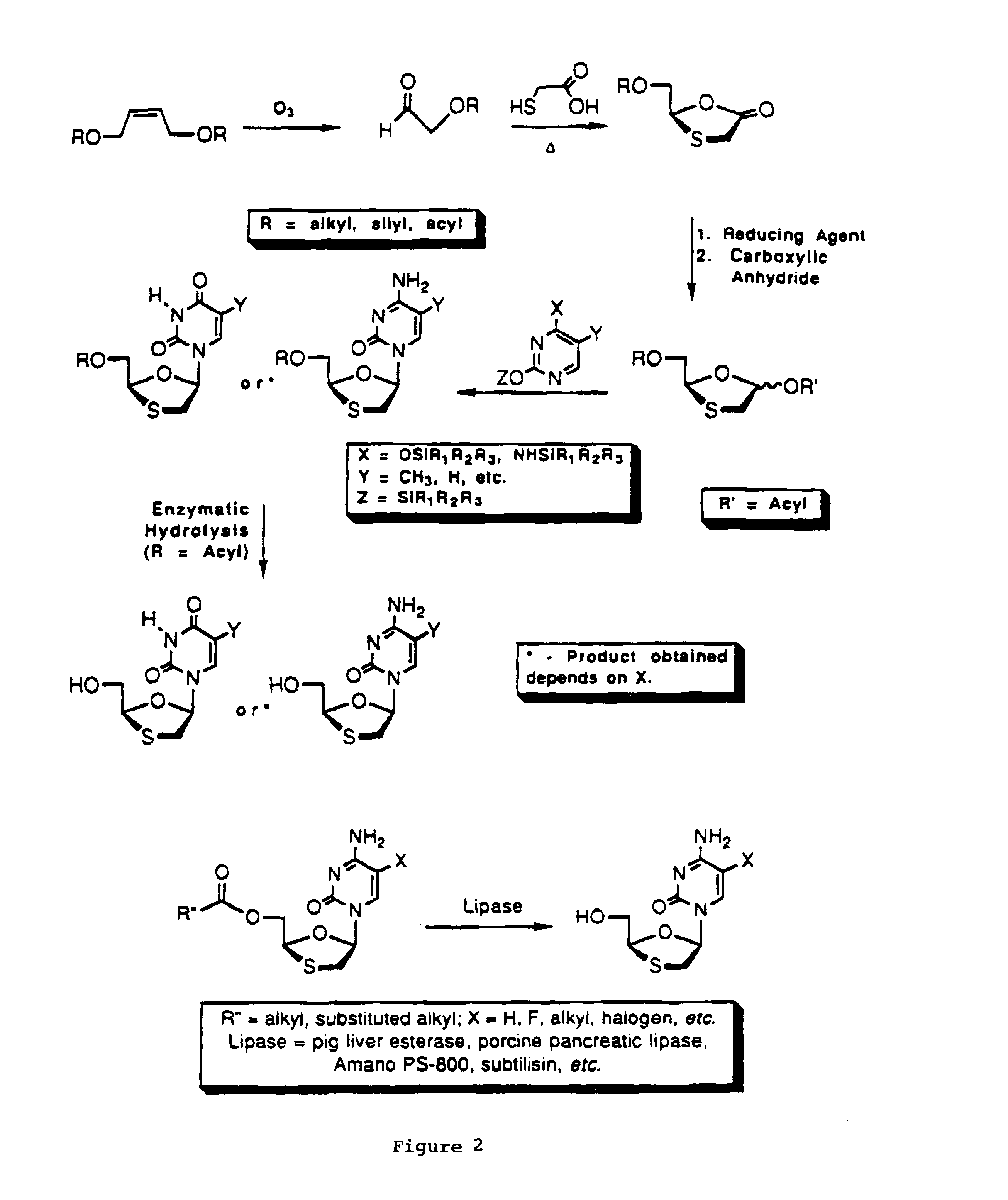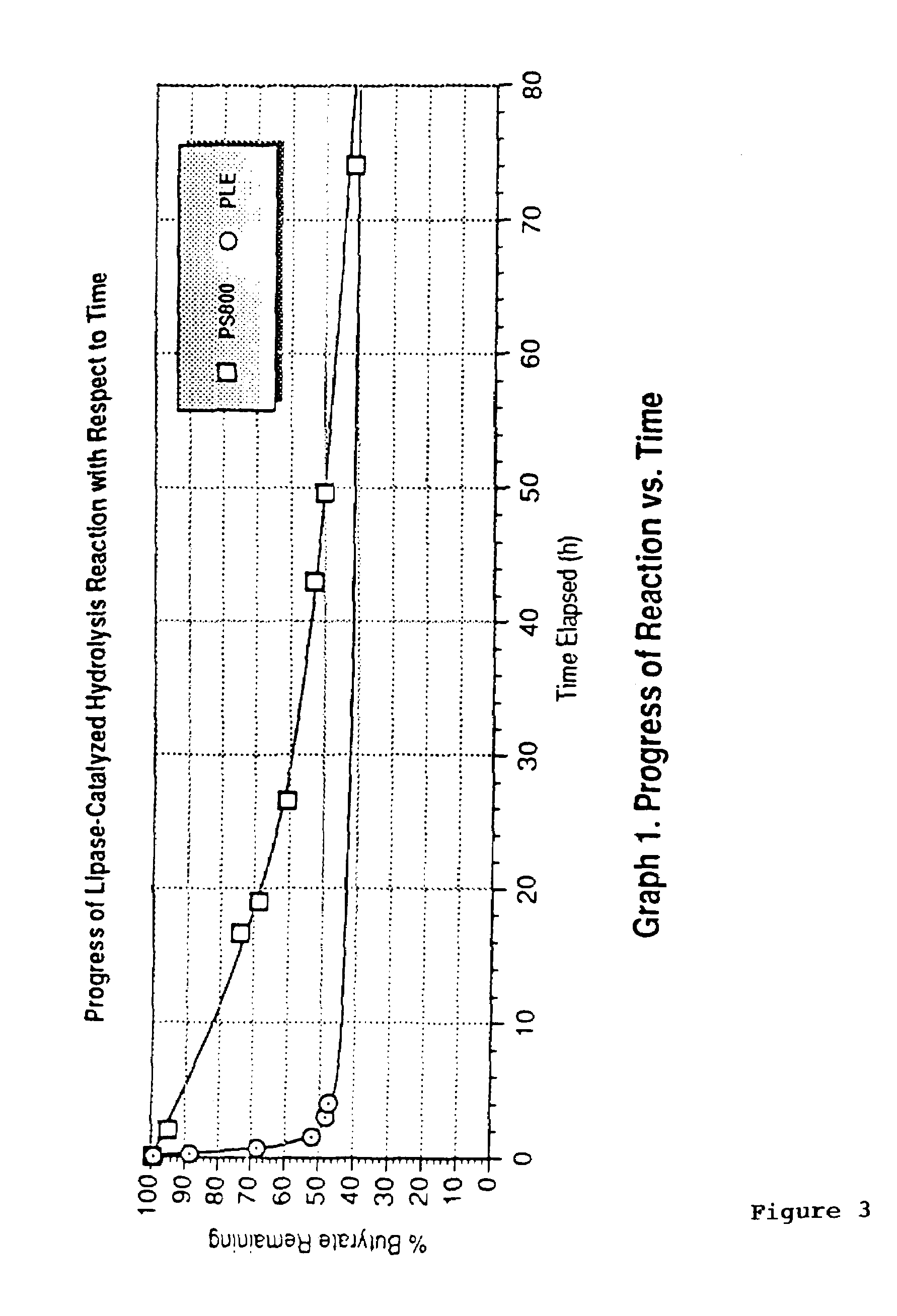Method of resolution and antiviral activity of 1,3-oxathiolane nucleoside enantiomers
a technology of oxathiolane and nucleosides, which is applied in the field of biologically active nucleosides, can solve the problems of peripheral neuropathies in humans, ddc and d4t are not efficiently converted to the corresponding 5′-triphosphates, and adverse side effects, and achieve the effect of moderate cos
- Summary
- Abstract
- Description
- Claims
- Application Information
AI Technical Summary
Benefits of technology
Problems solved by technology
Method used
Image
Examples
example 1
Enantioselective Lipase-Catalyzed Hydrolysis of FTC Esters.
[0045]A number of 5′-O-acyl derivatives of FTC were prepared by selective O-acylation of the N-hydrochloride salt (see Table 1) of (±)-FTC. The efficiency of the hydrolysis of the derivatives by lipases was investigated. As shown in Table 1, pig liver esterase (PLE) exhibits a high level of selectivity for the hydrolysis of the ester of the (+)-enantiomer of FTC. In contrast, PS-800 hydrolyses the ester of the (−)-enantiomer of FTC preferentially. The rate of the hydrolysis was also found to be dependent on the nature of the acyl group; the acetyl derivative was significantly slower than the butyryl derivative. It has now been discovered that the rate of the hydrolysis of the propionic acid ester of FTC is even faster than that observed for the butyrate derivative. % recovery and % ee were both determined using HPLC. Although the enantioselectivity is excellent when employing PLE (typically 97% e.e. or higher), additional en...
example 2
Procedure for the Preparation of (+)- and (−)-FTC via Enantioselective, Lipase-Catalyzed Hydrolysis of FTC Butyrate.
[0047]The 5′-O-butyrate of (±)-FTC (1) (0.47 mmol, 149 mg) was dissolved in 16 mL of a solution of 4:1 pH 8 buffer:CH3CN. The clear solution was stirred and treated with 26 mg of pig liver esterase (PLE-A). The progress of the reaction was monitored by HPLC (FIG. 3). After 20 hours (52% conversion), the reaction mixture was extracted with 2×80 mL of CHCl3 and 80 mL of ethyl acetate. The organic layer extracts were combined, dried over anhydrous MgSO4, filtered, and concentrated by rotary evaporation. The resulting residue was eluted on 2×1000 m pTLC plates using ethyl acetate as eluant (double elution) to give, after isolation, 53 mg (36% based on starting material) of FTC butyrate which was determined to have 98% enantiomeric excess (e.e.) by HPLC analysis. The enantiomerically-enriched butyrate was then treated with 1.6 mL of methanol followed by 0.38 mmol (20 mg) of...
example 3
Separation of Racemic Mixtures of Nucleosides by HPLC.
[0057]The resolutions of the C4′-enantiomers of (±)-BCH-189 and (±)-FTC were performed using a chiral cyclodextrin bonded (cyclobond AC-I) column obtained from Rainin Corporation (Woburn, Mass.). The conditions were as follows: Isocratic 0.5% methanol in water; flow rate 1 ml / min., UV detection at 262 nm. HPLC grade methanol was obtained from J.T. Baker (Phillipsburg, N.J.). The racemic mixtures were injected and fractions were collected. Fractions containing each of the enantiomers were pooled, frozen, and then lyophilized. The compounds were characterized by UV spectroscopy and by their retention times on HPLC. In general, the (−)-enantiomers have lower retention times than the (+)-enantiomers (see J. Liquid Chromatography 7:353-376, 1984). The concentrations of the compounds were determined by UV spectroscopy, using a stock solution of known concentration (15 μM) prepared in water for biological evaluation. The retention times...
PUM
| Property | Measurement | Unit |
|---|---|---|
| pH | aaaaa | aaaaa |
| enantiomeric excess | aaaaa | aaaaa |
| enantiomeric excess | aaaaa | aaaaa |
Abstract
Description
Claims
Application Information
 Login to View More
Login to View More - R&D
- Intellectual Property
- Life Sciences
- Materials
- Tech Scout
- Unparalleled Data Quality
- Higher Quality Content
- 60% Fewer Hallucinations
Browse by: Latest US Patents, China's latest patents, Technical Efficacy Thesaurus, Application Domain, Technology Topic, Popular Technical Reports.
© 2025 PatSnap. All rights reserved.Legal|Privacy policy|Modern Slavery Act Transparency Statement|Sitemap|About US| Contact US: help@patsnap.com



